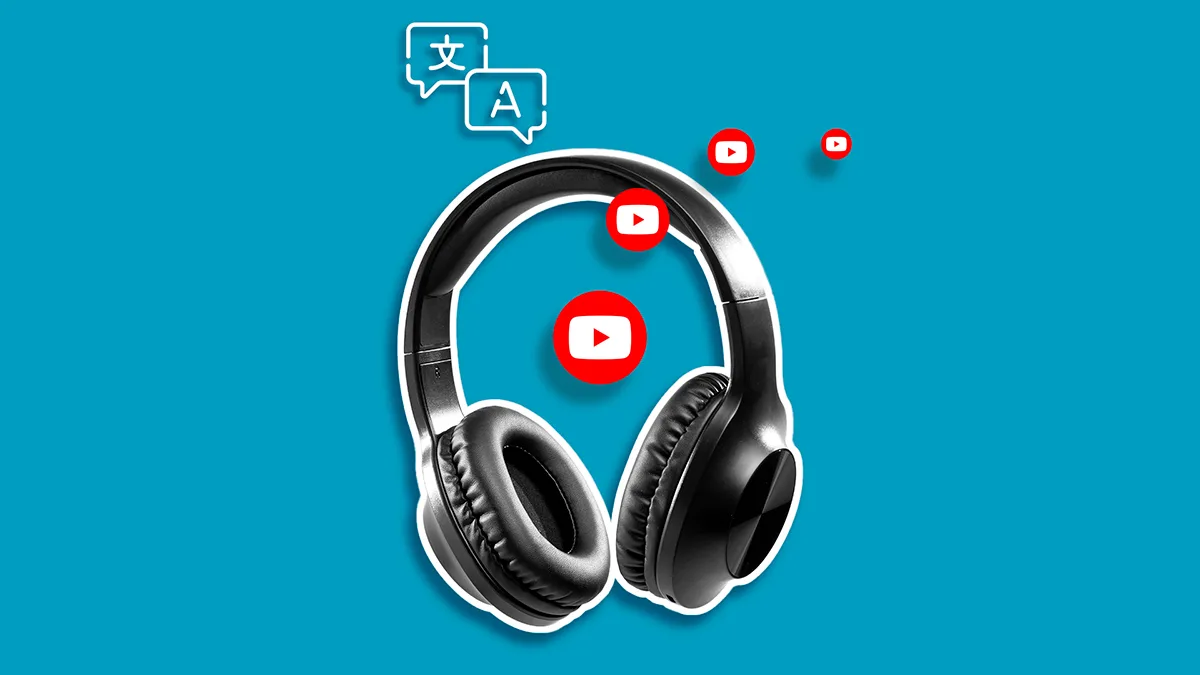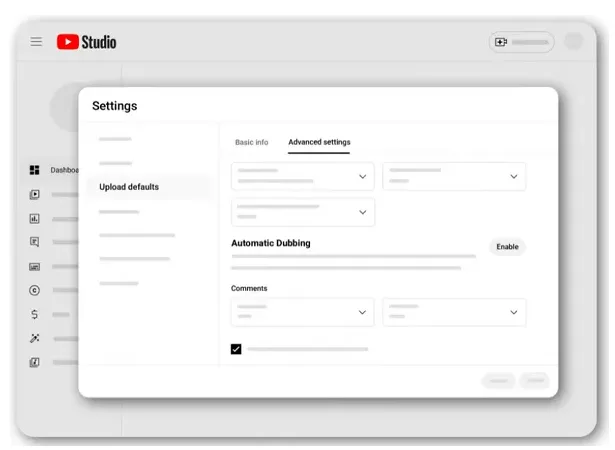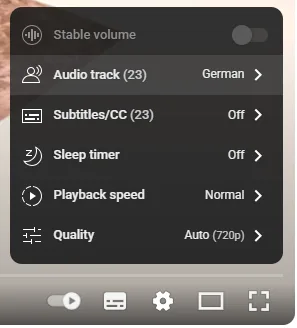YouTube Multi-Language Audio Tracks Now Available for More Creators

Following the expansion of YouTube auto-dubbing in June 2025, the multi-language audio tracks feature is now rolling out to more creators worldwide. After a two-year pilot, this tool now lets creators add dubbed audio tracks to their videos.
In this article, I’ll walk you through what YouTube multi-language audio tracks are, how auto-dubbing works, the key differences between the two, and which option makes the most sense for you depending on your goals.
Why YouTube Is Expanding Language Options
It all comes down to one fundamental part of human connection…
If you talk to a man in a language he understands, that goes to his head. If you talk to him in his language, that goes to his heart.
Nelson Mandela
Speaking to people in their own language is one of the most genuine (and still underused) ways to connect. And YouTube is making that possible with new tools that help creators bridge the gap.
Auto-dubbing was the first big step, giving millions of creators AI-generated dubbed audio. Now, after a two-year pilot, multi-language audio tracks are rolling out, letting you upload your own dubbed files directly into your videos.
Together, these features make your content more accessible and give you the chance to reach entirely new audiences.
What is YouTube Auto-Dubbing?
Think of auto-dubbing as the fast lane. It’s YouTube’s AI-powered tool that automatically generates dubbed audio tracks for your videos.
The difference between the two can be a bit confusing, so let’s get it straight: auto-dubbing is AI-powered and so can sound quite robotic, while YouTube multi-language audio tracks are controlled by the creators, giving them the freedom to tweak the audio as they like.
In a nutshell, auto-dubbing means:
- Your videos are labeled “auto-dubbed” so viewers know it’s AI-generated.
- Viewers can toggle between the original and dubbed tracks.
- No need to upload or record audio files yourself.
- Since June 2025, the feature has expanded to 80 million creators and supports 11 more languages.
👉 Best for: educational content, tutorials, or any video where speed and accessibility matter more than emotional nuance.
Who Can Get Access to Auto-Dubbing?
Since its launch, auto-dubbing has expanded to hundreds of thousands of channels in the YouTube Partner Program.
How YouTube Auto-Dubbing Works
- Upload Your Video
Just like you normally would! YouTube automatically detects your video’s language and generates dubbed versions in supported languages. - Preview and Manage Your Dubs
Check your dubbed tracks in YouTube Studio > Languages. You can listen, unpublish, or delete any dubs you’re not happy with. - Control Settings
If auto-dubbing is available for your channel, you’ll find it under Advanced Settings. You can also choose to review dubs before publishing to maintain some control over quality.

👉 For a comprehensive guide on using YouTube Studio, check out:
Supported Languages
- Currently, YouTube supports dubbing into English from 20+ languages (Spanish, French, Hindi, Japanese, and more) — and dubbing from English into 10+ languages. The list keeps growing, so expect more support over time.
- If your video is in any of those other languages, it will be dubbed into English.
- Viewers can switch between the original and dubbed audio tracks. YouTube remembers their language preference for future videos.
What to Keep in Mind About Auto-Dubbing
Auto-dubbing is still evolving, so translations might not always be perfect. Tone, emotion, and nuances may be less precise, but YouTube is working with Google DeepMind and Google Translate to improve expressive speech, aiming to emulate the creator’s tone, emotion, and even background ambiance in future updates.
That’s exactly where YouTube’s multi-language audio tracks step in as a stronger alternative. While auto-dubbing helps you scale quickly, multi-language tracks give you full control over quality and cultural nuance.
💡The smartest strategy? Combine manual uploads for your most important languages with auto-dubbing to maximize your reach worldwide.
What Are YouTube Multi-Language Audio Tracks?
Multi-language audio tracks are the more hands-on, premium option for your videos. Instead of relying on AI, you (or a professional) upload high-quality audio recordings in different languages.
Here are the most important specs of this feature:
- You can upload up to 30 languages per video.
- No need to create multiple channels for different languages.
- According to YouTube, videos with multi-language audio tracks have seen 25% of watch time come from non-primary languages.
- Ideal for universal topics like food, travel, gaming, tutorials, and more.
This feature gives you full control over quality, tone, and style, which makes it perfect for storytelling, premium content, or branded videos.
👉 Best for: creators who care about emotional impact, cultural nuance, or professional-grade content.
On average, creators uploading Multi-language Audio tracks to their videos saw over 25% of their watch time come from views in the video’s non-primary language.
YouTube

Multi-Language Audio Tracks vs. Audio-Dubbing: Key Differences
Now that we’ve explored both options, let’s break down the key differences and see how each one works in practice.
| Feature | Multi-Language Audio Tracks (Manual Uploads) | Auto-Dubbing YouTube (Automatic) |
| How it works | Record or hire voice-over talent, then upload manually in YouTube Studio. | AI automatically generates dubbed audio tracks when you upload a video. |
| Control over quality | Full control: tone, emotion, style, accuracy. | Limited: AI may misinterpret idioms, tone, or technical terms. Can review/edit before publishing. |
| Languages supported | Up to 30 languages per video. | Expanded June 2025: 20+ languages into English, 10+ from English, plus 11 new languages (some experimental). |
| Cost & effort | High: recording, editing, or hiring professionals. | Low: generated instantly, no extra cost. |
| Viewer experience | Polished, professional, expressive. | Fast and scalable; best for tutorials, explainers, evergreen content. |
| Availability | Pilot initially; now open to all creators for uploads. | Expanded June 2025 to all verified YouTube creators. |
| Best for | Storytelling, premium content, branded videos. | Quick global reach, accessibility, scaling tutorials or educational content. |
How to Upload Multi-Language Audio Tracks
If you want a more polished, nuanced translation and already have your audio tracks ready, adding them to your video is super simple:
- Sign in to YouTube Studio on your computer.
- From the left menu, select Languages.
- Pick the video you want to edit.
- Click Add Language and choose your language.
- Next to “Dub,” click Add.
- Upload your audio-only file (must be about the same length as your video).
- Hit Publish.
And that’s it! Your video now has multi-language audio.

How to Turn Off Auto-Dubbing YouTube
Don’t want automatic dubs on your videos? You can turn them off anytime:
- Go to YouTube Studio on your computer.
- Open Settings > Upload defaults > Advanced settings.
- Uncheck Allow automatic dubbing.
- Click Save.
You can turn it back on at any time, with the option to review dubs before they’re published.
Why This Matters for Social Media Managers
For creators and brands, it’s a great opportunity for growth. Adding YouTube multi-language audio tracks or using YouTube dubbing can:
- Help your content perform in global markets.
- Improve retention, since viewers prefer hearing content in their own language.
- Save you time and money compared to traditional dubbing.
If you’re managing a brand channel, experimenting with YouTube auto-dubbing is a smart first step. Even if translations aren’t perfect, the potential reach and traffic boost are hard to ignore.
But once you see the benefits, the next question naturally is: which languages should you start with? Choosing the right languages can make all the difference in connecting with your audience worldwide.
Choosing the Right Languages for Your YouTube Multi-Language Audio
Let’s say your video is more than just a tutorial and your audio is ready. How do you decide which languages to start with? The key is understanding your audience and matching your content to the right regions. Here’s a simple guide to help you choose wisely:
1. Dive Into Your Analytics
Start by checking YouTube Studio to see where your viewers are coming from. Which countries bring in the most views? Take a peek at the languages used in comments or auto-translation metrics. Many successful creators start with languages that already make up a big part of their audience. For example, a cooking channel might notice strong engagement from Spanish- and Portuguese-speaking regions and prioritize those dubs first.
2. Think Global Reach
Some languages cover multiple countries. Spanish, for instance, works across Spain, Latin America, and beyond. French, Arabic, or Hindi also reach large regions. If your content has broad appeal — like tutorials, lifestyle videos, or entertainment — starting with widely spoken languages can instantly expand your potential audience.
3. Match Your Content Niche
Consider your video topics and which cultures might connect. Pasta recipes? Italian or Spanish could be perfect. K-pop dance covers? Korean or Japanese might make the most sense. The goal is to find languages that naturally fit your content.
4. Listen to Your Viewers
Your audience can guide you. Watch for comments like, “Please dub this in French!” or “I wish my parents could watch this in Hindi.” Even better, ask directly in a community post which language they’d like next.
Start small with one or two languages as a trial — no need to offer ten from day one. Once you see results, like a bump in views from new regions or enthusiastic comments, you’ll know it’s time to expand further.
Boost Your YouTube Strategy with Metricool
All these YouTube tools are powerful, but managing multiple languages, analyzing performance, and planning content can get tricky fast. That’s where Metricool comes in.
With Metricool, you can:
- Track performance across all languages and videos: see which dubbed or auto-dubbed content drives the most views, watch time, and engagement.
- Plan your video calendar: schedule uploads for different regions and languages to maximize global reach.
- Monitor audience feedback in one inbox: manage comments and DMs across multiple platforms, so you never miss requests for new language tracks.
- Optimize your strategy with analytics: identify which regions and languages are your growth hotspots and prioritize your multi-language efforts.
💡 Pro Tip: Combine YouTube multi-language audio tracks with Metricool analytics to see exactly which languages resonate most with your audience—and plan your next uploads for maximum impact.

